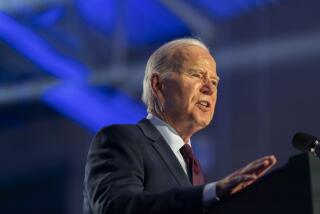Holding Juvenile Court
- Share via
Adolescent leaders were not born yesterday. They’ve been around since the beginning of civilization. And some of them make today’s immature corporate bosses look like Boy Scouts.
Unlike current U.S. political and business leaders whose behavior is tempered by the Constitution or by a board of directors, many early leaders were monarchs with almost unfettered power. With coups the biggest threat to their rule, insecure leaders were as likely to kill subordinates who issued a challenge as they were to dismiss them.
Not all monarchs abused the power of their throne or put their own ego needs ahead of their subjects. Many mature leaders channeled their power for the common good. And a few have been true visionaries whose historic achievements moved society forward and whose influence is felt today.
“We’ve all got egos, but some of us are consumed by them and others put our egos to work for a higher goal,” said Michael Genovese, Loyola Marymount professor of political science.
Many early monarchs behaved like adolescents for good reason: They were teenagers when they came into power. Used to getting their way as children, they subsequently never grew up.
Nero was born into a family known for its cruelty and debauchery. When he inherited the mantle of Roman emperor at 16, he continued the tradition.
In the early years of his rule in the 1st century, Nero let his former tutor Seneca manage the day-to-day affairs of the state. Seneca was a classic adult leader, guarding the frontiers, keeping corruption at bay and maintaining peace. But Nero soon became interested in the state’s finances and forced Seneca to commit suicide.
Like Emperor Caligula before him, Nero was known for his extravagance and excesses, seeking only to gratify his own immediate desires. He drained the state’s treasuries, stripped the temples and confiscated estates. At 22, he murdered his mother and later one of his wives. When he gave musical performances, he ensured himself a captive audience by promising to kill anyone who left early. After he was overthrown at age 31, he committed suicide.
Alexander the Great, the early Macedonian king and general, came into power as a teenager, but his legacy is very different. A charismatic leader, Alexander was both a mystical thinker and a powerful military leader. But his conquests were in the name of reconciling cultures and creating a commonwealth of East and West. His empire building resulted in a new trade network, thriving cities and the birth of an enlightened Hellenistic Age. He is described as a god or a saint in the folklore of many Eastern cultures.
The Greek mathematician Eratosthenes said of Alexander, “He is the reconciler of the world, pouring human beings together like wine in a loving cup.”
Another young ruler, Henry V, is generally recognized as having had a successful reign. But he was restless to go to war and repeatedly did so even though it was not the wisest course of action for his country. “Henry V assumed the throne at a very young age and like a teenager who gets a new car, he wanted to take it out for a spin,” said Dean Keith Simonton, professor of psychology at UC Davis.
In a battle with the French immortalized in one of Shakespeare’s best-known plays, the 14th-century British ruler exposed his soldiers to a campaign they had almost no chance of winning. But luck prevailed, and he enjoyed an unlikely victory.
In the mid-16th century, Ivan the Terrible became Russia’s grand prince at age 3. At 13, he ordered his first execution; later, he executed thousands, including his own heir. His rule was marked by the terror that he inflicted on his people with armies of black-garbed troops.
But this tyrant was also a devout Orthodox Christian who loved music. He built a lavish cathedral in the Kremlin, and legend has it that he had the architects blinded when the work was finished so they would never build anything more beautiful.
Scholars say it is typical for leaders to be aggressive, selfish and rash in early adulthood, but to be motivated by encroaching mortality to give something back to society in middle age.
“In general, monarchs go from being very militaristic when young, interested mostly in self-aggrandizement and in expanding the boundaries of their country to looking at their country’s domestic needs later in their reign,” said Simonton, author of “Greatness: Who Makes History and Why” (Guilford Press, 1994).
Julius Caesar evolved from being an unscrupulous politician who racked up debts and engaged in power struggles and bribery to becoming a magnanimous statesman and far-sighted reformer later in his career.
Napoleon Bonaparte took the opposite path. Inspired by the ideals of the French Revolution, he started out as an effective military leader and reformer. But later, hungry for power, he forced his troops into disastrous battles, indifferent to their needs for food, clothing or medical treatment.
The monarchy also has contributed its share of female rulers, with Elizabeth I being regarded as one of the most successful. Both Britain’s Elizabeth I and Russia’s Catherine the Great are described by Simonton as “alpha” females--strong, dominant and charismatic.
Catherine raised eyebrows with her parade of young lovers, and she is thought to have had her eccentric husband killed so she could rule the country. “She had no problem using men to meet her own needs, very much like Elizabeth I,” Simonton said.
While both women were autocratic and manipulative, historians give them high marks for building the influence and strength of their countries for centuries to follow.
England flourished in the 17th century under Elizabeth, and Catherine created a formidable empire, raising the standards of Russian culture and education during her lengthy rule.
America’s founding fathers recognized the problems inherent in immature leaders from their knowledge of British kings, so they established a minimum age of 35 for U.S. presidents. They also created checks and balances that make it difficult for any leader to wreak too much damage on the nation.
By all accounts, the early presidents were a remarkable group of mature leaders: far-sighted, restrained and acutely aware of their historical role in shedding monarchy rule and establishing a democracy.
“George Washington, on several occasions, could have been king. He simply refused,” said Genovese, co-author of “The Paradoxes of the American Presidency” (Oxford University Press, 1998). “How many people would be able to do that? He was dedicated to a higher principle.”
Genovese added, “It’s not that he or any of these early leaders were lacking in ego or ambition. It’s that their egos were under control and their ambitions put to a higher purpose.”
Lincoln probably exemplified a mature leader more than any other.
“The tendency in a crisis is to over-personalize,” Genovese said. “Lincoln was able to rise above that and seek out, not his own salvation, but the higher values of the democracy, preserving the union, freeing the slaves and reinterpreting and revitalizing democracy to move it into the next period.”
Another president in the maturity hall of fame: Franklin D. Roosevelt. FDR faced both the Great Depression and World War II, exhibiting empathy and inspiring the nation with his vision of a better future.
His influential first lady, Eleanor Roosevelt, did the same. “She acted because she saw problems and wanted to solve them, not to make up for her ugly-duckling background or inadequacies,” Genovese said.
Theodore Roosevelt, however, is considered a classic adolescent leader. Though the “Rough Rider” was an effective president, he was also impulsive and immature.
Said Genovese: “He used to lament repeatedly the absence of a war, saying, ‘It takes a war or a crisis for greatness to be released and, damn it, I don’t have a war.’ ”
The story goes that when Congress wouldn’t authorize a world tour for the Navy, Roosevelt told them he had enough money to send it halfway around the world, and then asked, “Would you like to get your Navy back?”
And what about those icons of the Industrial Age, American business leaders such as John D. Rockefeller, Andrew Carnegie and John Piermont Morgan? These were disciplined, often highly religious leaders whose drive and ruthless competitiveness enabled them to organize and dominate their industries.
While they became known as robber barons for their accumulation of wealth at others’ expense, they recognized a responsibility to society and, later in life, gave away huge fortunes through philanthropic foundations.
The 20th century has more than its share of truly destructive adolescent leaders, topped by Adolf Hitler, with his well-documented atrocities. And in Russia under Joseph Stalin, “The whole state was organized around his ego. People had to rewrite history when he changed his mind,” Simonton said.
Leaders like this often are able to appeal to the insecurities of their followers, instead of inspiring them to greatness as did visionary 20th century leaders such as Mohandas Gandhi, Mother Teresa and Martin Luther King.
Richard Nixon was another insecure, narcissistic leader. “In the 1972 election, he didn’t just want to beat McGovern, he wanted to win by a landslide,” Simonton said. And that led to his downfall.
“Some adolescent leaders can go through their lives and careers without mishap, but they have an inability to see clearly what to do when things go wrong,” Genovese said. “Instead, they circle the wagons and let their egos overwhelm their decision-making. A wise leader more objectively analyzes the situation. They say, ‘Maybe I screwed up here, and I should do something about it.’ ”
As with Winston Churchill, who exhibited adolescent traits but later matured, people are not fixed for life. “In those rare moments when history presses you into action, you are motivated to succeed,” Genovese said. “Even adolescents can become great leaders.”
More to Read
Sign up for Essential California
The most important California stories and recommendations in your inbox every morning.
You may occasionally receive promotional content from the Los Angeles Times.














